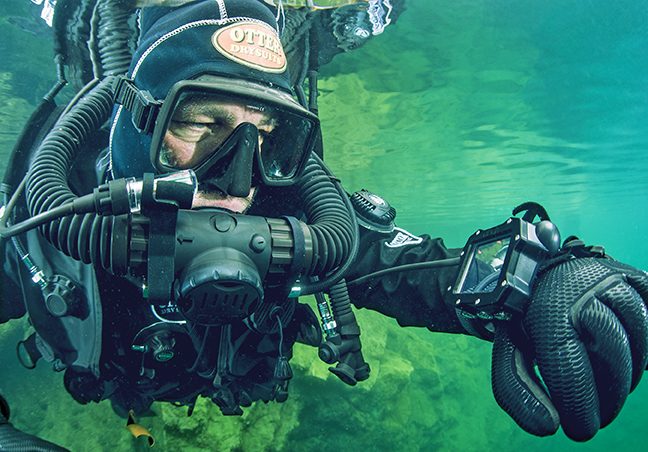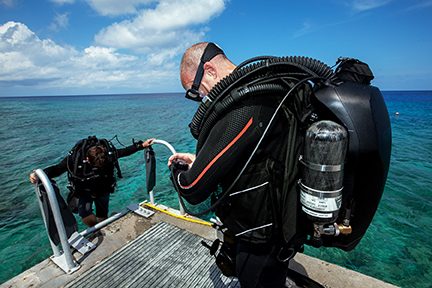LA POPULARIDAD DE LOS REBREATHERS (recirculadores) de circuito cerrado (CCR, por sus siglas en inglés) ha crecido mucho a lo largo de los últimos años. Se están convirtiendo cada vez más en una norma en la comunidad de buceo técnico, y los buzos deportivos y científicos también están descubriendo sus beneficios. Probablemente conozca a al menos un buzo que utilice CCR, y a menudo proclaman sus beneficios. ¿Qué tan precisas son estas afirmaciones? ¿Los buzos con CCR están intentando mostrarles la luz a los buzos con equipos de circuito abierto, o están tratando de justificar su compra de USD 10.000? Evaluemos algunas afirmaciones populares sobre los CCR.
LOS REBREATHERS SON MUCHO MÁS
LIVIANOS QUE LOS CILINDROS DOBLES.
En el sentido literal, esta afirmación es cierta. Un juego de cilindros de acero dobles como los que normalmente utilizan los buzos técnicos pesa más de 45 kg (100 libras), mientras que un CCR pesa aproximadamente 23 kg (50 libras), dependiendo del modelo. Pero ese no es el panorama completo. Los cilindros dobles ofrecen redundancia a través de un colector o una configuración de montaje lateral. El buzo debe llevar un cilindro de emergencia independiente para tener un suministro de mezcla respiratoria redundante siempre que bucee con un CCR. Para un buceo de descompresión, un buzo con CCR también lleva al menos un cilindro de gas de descompresión en caso de que se produzca una falla del CCR. Es importante que planifique sus necesidades de mezcla respiratoria y que lleve el equipo adecuado según su plan de buceo. Si bien el CCR en sí pesa menos que un juego de cilindros dobles, también debe considerar el peso y el volumen de los cilindros adicionales.
TIENE UN SUMINISTROS DE GAS SUFICIENTE
PARA REALIZAR BUCEOS DE VARIAS HORAS.
Al utilizar un CCR, en efecto tendrá un suministro de gas extenso, y también contará con más gas para emergencias que el que tendría con un circuito abierto. Es posible que opte por no realizar buceos largos ni tener tiempos de fondo prolongados, pero tener horas en lugar de minutos de mezcla respiratoria de reserva supone beneficios de seguridad.

El instructor de CCR Pete Mesley controla su pantalla mientras bucea en Vobster Quarry en el Reino Unido.
LOS REBREATHERS SON
DIFÍCILES DE ENTENDER.
Es más probable que esta idea mantenga a las personas alejadas de los rebreathers en lugar de atraerlas a ellos. No se puede negar que los rebreathers son más complejos que los equipos de buceo de circuito abierto. Pero no son tan complejos como tal vez ha oído. La mayoría de las personas pueden comprender los conceptos del funcionamiento de los rebreathers, pero bucear con un rebreather requiere mucho más que simplemente entender cómo funcionan. Tener autodisciplina es fundamental. Durante la capacitación de buceo con rebreathers es posible que oiga: “esta máquina intentará matarlo. Su deber es evitar que tenga éxito”. Suena melodramático, pero es cierto.
La complejidad del equipo agrega más puntos de falla potenciales que los equipos de circuito abierto. Una falla en uno de los muchos sellos de juntas tóricas, los sistemas electrónicos o el absorbente de dióxido de carbono puede ser fatal. Es necesario tener un cuidado meticuloso para reducir los riesgos de que se produzca una falla en el equipo. Cada fabricante de rebreathers ofrece listas de verificación que debe completar antes de cada buceo. No completar la lista de verificación anterior al buceo o ignorar los elementos que no cumplen con el control anterior al buceo solo traerá problemas. Los rebreathers necesitan un cuidado particular después del buceo e ignorar estos procedimientos puede dar lugar a malos resultados. Estos procedimientos anteriores y posteriores al buceo no son difíciles, pero son esenciales y requieren mucho tiempo. Si habitualmente coloca su equipo de circuito abierto en la parte posterior de la camioneta después del buceo y no lo examina por varios días, tendrá que cambiar ese hábito si comienza a utilizar un rebreather.

Este equipo mixto deja ver a un buzo con CCR llevando más gas que su compañero con equipos de circuito abierto en Madison Blue Spring, Florida.
APRENDER A BUCEAR CON UN REBREATHER ES
COMO VOLVER A APRENDER A BUCEAR.
Además de dinero, también debe dedicar tiempo. El aspecto de dedicación del buceo con CCR es en lo que una persona con autodisciplina se destacará. No puede comprar un rebreather e inmediatamente comenzar a realizar buceos profundos con Trimix. Hay una curva de aprendizaje que a menudo es como volver a empezar. Necesitará tiempo para volver a aprender a bucear y dominar la flotabilidad con un CCR, incluso si ya tiene muchos años de experiencia en buceo con equipos de circuito abierto.
La mayoría de las agencias de capacitación requieren una cantidad mínima de horas de entrenamiento antes de avanzar al siguiente nivel. Comenzará en un curso de buceo con CCR con aire como diluyente, que es como el curso de buceo en aguas abiertas del mundo de los rebreathers. Después de este curso, recibirá su certificación para bucear a 30 metros (100 pies) sin paradas de descompresión obligatorias. Si desea descender más y hacer buceos más complejos, el siguiente paso es un curso de buceo de descompresión con aire como diluyente. Para inscribirse en este curso, normalmente necesita un mínimo de 30 a 50 buceos o 30 a 50 horas con el CCR. La certificación a este nivel le permite bucear a 40 metros (130 pies) e incluye la capacidad de realizar paradas de descompresión. Los requisitos previos y los objetivos del curso varían dependiendo de la agencia de capacitación. Además del curso de buceo de descompresión con aire como diluyente, puede tomar cursos donde se enseñe buceo con mezclas respiratorias incluso a mayores profundidades con helio (Trimix). Los buceos profundos con mezclas respiratorias son donde los rebreathers se destacan.


Arriba: Un buzo participa en una clase de rebreathers en el naufragio del Gaviota tridáctila en la isla Gran Caimán.
Izquierda: Greg Such y Kevin Gurr hacen un buceo de prueba en Divetech, Gran Caimán.
PODRÁ RECUPERAR SU INVERSIÓN
AL AHORRAR EN LOS COSTOS DEL HELIO
No hay duda de que los rebreathers son costosos. Un rebreather y la capacitación fácilmente pueden tener un costo de USD 10.000. Pero si bucea con Trimix, puede ahorrar en helio. La mezcla respiratoria para los buceos profundos contiene helio para reducir la narcosis por nitrógeno, pero es costosa. Cuando este artículo fue escrito, el precio del helio cada 28 litros (un pie cúbico) era de USD 3 a USD 5 en el Medio Oeste. Si llena cilindros dobles de 2.690 litros (95 pies cúbicos) —5.380 litros (190 pies cúbicos) en total— con una mezcla que contiene 45 por ciento de helio, el costo del helio será de USD 256,50 (sobre la base del costo de USD 3 cada 28 litros [un pie cúbico]). Tres litros es un tamaño típico para los cilindros de rebreathers, que pueden albergar aproximadamente 736 litros (26 pies cúbicos) de mezcla respiratoria. Llenar ese cilindro con una mezcla que contenga 45 por ciento de helio requeriría USD 35,10 en helio. Es un ahorro considerable, pero debe invertir mucho dinero antes de llegar a obtener ese ahorro. A menos que bucee con Trimix con frecuencia, es posible que nunca recupere la inversión.
La disponibilidad de helio puede ser una razón más imperiosa que el costo para bucear con un CCR —el precio y el suministro varían ampliamente según la región geográfica—. A veces hay una escasez misteriosa, lo que hace que los centros de buceo no puedan obtenerlo a cualquier costo. Debido a que el helio no siempre está disponible pero siempre es costoso, prefiero ser lo más eficiente que pueda con él. Se puede llenar siete cilindros de rebreathers con el mismo volumen de Trimix idéntico al que se usaría para llenar un juego de cilindros dobles de 2.690 litros (95 pies cúbicos). Nuevamente, deberá hacer eso con frecuencia para recuperar el gasto inicial para que nuevos cilindros se ajusten a su rebreather.
ALGUNAS LOGÍSTICAS SON DIFÍCILES.
Mi compañero y yo hemos estado buceando con equipos de circuito abierto por muchos años, y viajamos por la región de los Grandes Lagos de América del Norte cada verano boreal para bucear en naufragios. Por algún motivo, los barcos nunca se hunden cerca de grandes ciudades con buenos centros de buceo —siempre parecen estar en el medio de la nada—. Mi compañero compró un remolque adjunto que cargábamos con varios juegos de cilindros dobles, botellas de descompresión y otras piezas de parafernalia de buceo para cada excursión.
En un viaje, llegamos con nuestra tienda de buceo sobre ruedas para encontrarnos con nuestros compañeros de buceo para disfrutar de la semana, una pareja de buzos con CCR que ya estaban allí y se habían instalado. La preparación adicional y los pasos de mantenimiento pueden llevar más tiempo que con equipos de circuito abierto, por lo que los buzos con CCR a menudo necesitan comenzar temprano. También es crucial planificar cómo viajar con los cilindros que necesita y conocer qué hay disponible en su destino —la mezcla respiratoria puede ser limitada y costosa en determinadas áreas—.
No obstante, estos dos buzos eran claramente experimentados y habían elaborado su rutina. La mejor parte era que tenían todo su equipo para la semana en la parte trasera de una camioneta con lugar para un refrigerador, una parrilla de carbón, maletas, provisiones y quién sabe qué más. Miré nuestro remolque y finalmente caí en la cuenta.
Entonces, ¿cuál es la conclusión? ¿Los rebreathers son todo lo que proponen ser, o solo son herramientas costosas? La verdad es que son algo en el medio, dependiendo de su punto de vista.
Cuando considere dar el salto al buceo con rebreathers, debe analizarlo con cuidado desde todos los ángulos, incluido el costo, cuánto bucea, su capacidad de adaptación y el tipo de buceo que hace. Un rebreather no es para todo el mundo, pero puede ser la opción adecuada para usted, especialmente si sabe en qué se está metiendo y se prepara para dedicar el tiempo necesario para recibir buena capacitación y mucha paciencia.
Alert Diver - Q2 2022